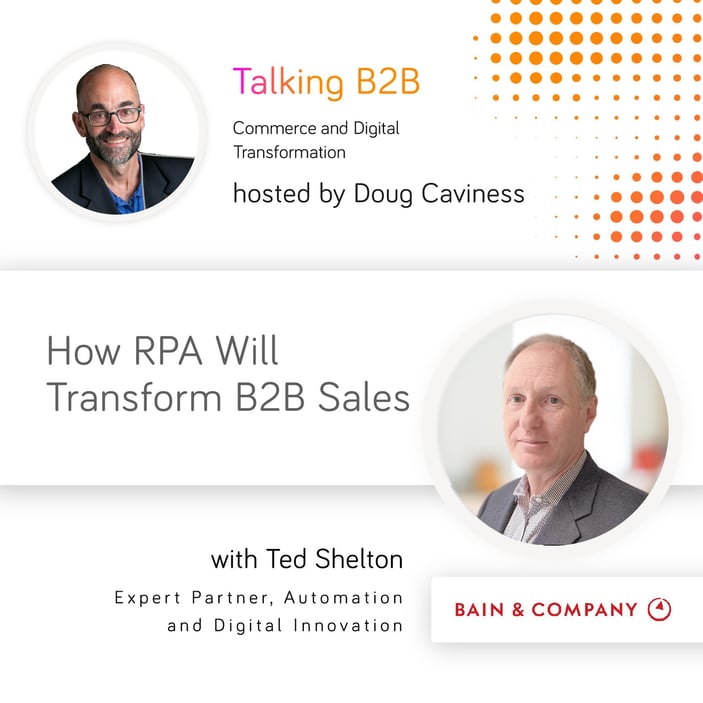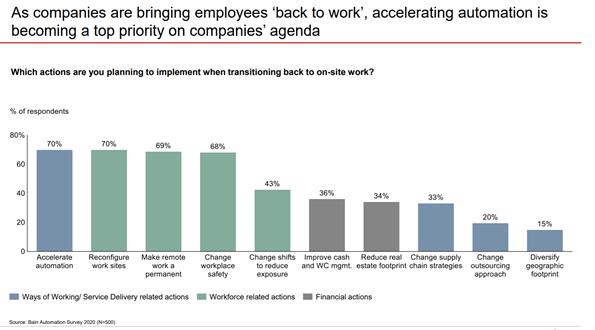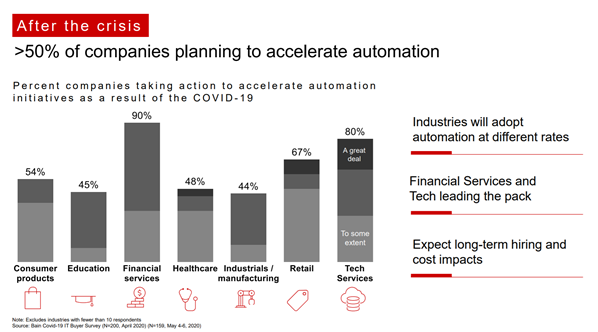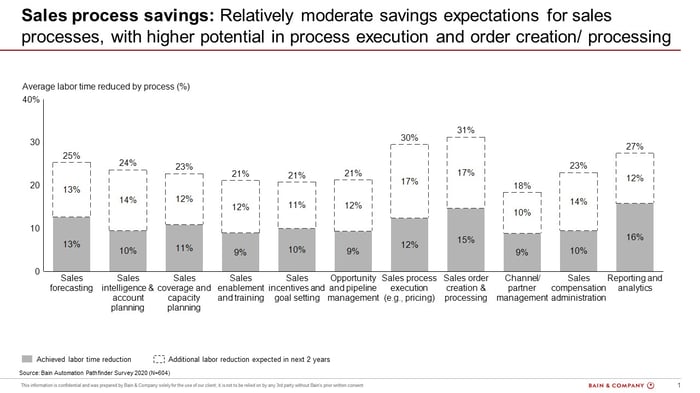How RPA Will Transform B2B Sales
Bain & Company Expert Partner, Automation and Digital Innovation Ted Shelton joins us in this Q&A to share his expertise and insight on how …
Written by

Share this post
Subscribe for best practices on optimizing your software business.
Listen to this article

Bain & Company Expert Partner, Automation and Digital Innovation Ted Shelton joins us in this Q&A to share his expertise and insight on how robotic process automation (RPA) is changing the B2B sales ecosystem – for the better!
But first, a primer on RPA…
- RPA is “the use of computers, or bots, to perform work that humans would normally perform. An RPA bot can read and understand documents, it can perform data entry, and process items like invoices. While artificial intelligence (AI) uses computers to think, RPA uses computers to carry out tasks.” (Forbes)
- RPA is the fastest-growing enterprise software market and is expected to reach $1.9 billion in 2021, an increase of 19.5% from 2020. Enterprise investment continues despite the economic uncertainties related to the Covid-19 pandemic. (Gartner)
- RPA is often used to automate repetitive manual tasks of humans interfacing with legacy software where suitable APIs are not available or where integration is cost prohibitive.
Doug: How would you explain RPA?
Ted: There’s been an evolution of what people mean by the term RPA, which was initially focused on emulation of computer mouse movements and limited to following a strict set of rules. It was usable for only a specific set of tasks. However, within the last couple of years there are two major trends to highlight:
- Vendors are expanding the scope of RPA to what many call “Intelligent Automation,” which includes two new aspects:
- Work orchestration: blending the combination of people and bots
- Interpretation: AI and machine learning
- The footprint of automation is now creeping from the back office into front office activities, such as in sales. Sales has more variables involved and now with data interpretation being supporting by automation, it offers a lot of opportunities.

“The difference is that there’s automation – an intelligent agent – available to a user on their desktop for processes that are really human-driven processes, where the human wants to pull the automation in at particular points in the process to do something.”
Doug: Could you share more about how RPA is working its way into supporting front-office activities?
Ted: You see it in something that the market has called Robotic Desktop Automation, or RDA to distinguish it from RPA. The difference is that there’s automation – an intelligent agent – available to a user on their desktop for processes that are really human-driven processes, where the human wants to pull the automation in at particular points in the process to do something. That’s one flavor of this front office or customer-facing activity. Another is Process Automation, where you’re orchestrating the work between people and machine learning and rule-based bots.
RPA is often used in customer self-service. An example might be when you have a common task that customers want to do when they call you, like check the balance of an account. Now you could write new software code so that in the interactive voice response (IVR) system when a customer presses #2, it goes out and executes that code and it finds out their balance and it reads it back to them. However, RPA could also be used to do that. I could say, when the person presses #2, then use the same human interface that my agent would have used to look up their balance and read it back to them. This way the automation can become a stop-gap, being able to automate that self-service experience without requiring coding. There’s certainly a bunch of use cases like that, but let me let me talk specifically about sales.
Let’s look at four very different independent activities in a sales person’s life: creating sales presentations, responding to RFPs, contracting and renewals.
Creating Sales Presentations
Automation can help salespeople create a more accurate presentation or proposal, an area typically involving a lot of repetition. For example, we worked with a B2B sales organization of a manufacturer that sells thousands of products through distributors, who in turn sell to businesses. They’ve got 500 people producing presentations every month, and they want to make sure that they have the most updated product information. So you’ve got your most expensive, most valuable resources running around trying to find the most current product info to put into a presentation every month. It’s an enormous task. And it sounds crazy, right?
We created a way for the salespeople to automate the process of including current product information into their presentations. Sales people choose which products they want to include in their presentation. Then the automation pulls the latest information from each of the product marketing organizations; assembles it and delivers updated slides back to the salesperson.
There is this wonderful side benefit as well. Previously, none of the product organizations had any visibility into how often their products were being pitched. Now, by having all the salespeople use this mechanism they’re suddenly able to collect data about which products are being pitched to which distributors and when. This is actually about transforming the organization.
Often when people think about automation they say, Oh, it’s about labor reduction. Yes, there was this opportunity to reduce the wasted time of my salespeople who were not able to be on the phone selling products, because they were running around getting signatures, but it wasn’t about reducing salespeople. It actually freed up time to do something more valuable and we also gained visibility into what’s being pitched. Now you can make smarter decisions as an organization.
Responding to RFPs
When you get an RFP, you are answering the same questions over and over again. How long have you been in business? Do you have the proper insurance? You know, all these questions you’ve got to keep answering with updated info… Now the automation process can read the RFP, and generate a document. You’re still going to have a person proofread and customize the document, but you can cut half the time out by not having to chase information. You can spend more time actually creating a great compelling pitch, right?
Contracting & Renewals
Contracting is a ton of repetitive work. Every contract needs to be customized with customer data that’s probably in your CRM system. Well, robots can do that. They can retrieve that information from the CRM, find the billing address, shipping address, and all that. Then a bot can route the document to relevant internal constituents. So instead of asking a salesperson to run around and chase those documents, a bot can do the chasing. It can send it to the legal team. It can say, hey, it’s been three days and you haven’t responded, and I’m following up now. Let the bot respond, let the bot chase things down. It can even handle routing the document through something like DocuSign, and then filing it in the proper place.
Realized benefits: Freeing up time for higher-value selling; Enhancing the customer experience by reducing time to quote and complete a transaction; Improving quote accuracy and data quality.
Doug: So when it comes to larger organizations with hundreds of people completing manual steps to prepare quotes for subscription renewal with legacy systems… why aren’t we hearing more about them already deploying RPA for this for kind of process?
Ted: There’s a misperception about automation capabilities. A lot of people think it’s just back office stuff. They think it’s repetitive rule-based automation, instead of understanding that it can be actually inserted right at the desktop. So those people creating the quotes, can push a button instead of going to the six different systems to get the information they need.
You don’t take that task and just say, poof, it’s gone, right? We take a task within a process and automate it. It’s about how to orchestrate that process.
May people managing front-office activities don’t realize how automation can help them. Typically the automation knowledge in organizations lies with those global business services, shared services, back-office functions, and the sales teams haven’t even heard of it. That’s what’s changing right now! You will hear more and more about front-office automation happening in real organizations.
(Update from Doug: I know of a vendor that is now generating thousands of renewal quotes each month using RPA, replacing a labor-intensive process where each quote required 20 to 50 minutes of a rep’s time working across five to six different applications. Rather than focusing on cost reduction, this vendor’s motivation and realized benefits were primarily about: freeing up employee time for higher-value selling; enhancing the customer experience by reducing time to quote and complete a transaction; and improving quote accuracy and data quality.)

Doug: What are some of the obstacles to overcome for implementing RPA?
Ted: I think there are three things. Number one is that it’s not just an IT initiative, it requires the business side to work together with IT. Instead of it being a system to support a business process, it actually is the business process, and it changes the business process.
So you’ve got to have the business involved in thinking through how they will use it, how it will be implemented, and then actually managing the change. They have to change the way they work to be able to operate in a new way. The first change that has to happen is organizations have to be able to move to a governance model for this technology where they recognize that this is about business transformation. It is the business and the IT organization working together to make it happen.
I think that raises the second problem, which is that organizations don’t understand many of their own business processes. If I asked three different people at a company how a particular thing works in the company — I ask a C-suite executive, I ask the manager of the process, and then I ask the person who actually does the work — I will get three different answers. Very little effort has been into business process improvement and standardization and documentation for sales processes, and that becomes a big problem.
And then the third issue is that you’ve got to overcome cultural perceptions to help people understand RPA can be part of a transformation that empowers employees and customers. So you can either approach employees by saying, hey, guess what, I don’t need this work done by people anymore. Or you can say, I need you. You are the most valuable asset we have, but you’re being used in the wrong way. Let them know you want to reuse their time in a much more productive way – basically, let’s go reinvent your job! That’s a huge mental shift – for the frontline employees – for the managers – and for the C-suite to go through this type of organizational change. That’s much harder than the technology implementation. Technology changes are easy compared to the mental and cultural changes.
Doug: In the field of RPA, what are you most excited about in terms of where things are going?
Ted: I’m most excited by moving to a model in which all the activities of a business are producing data and that data is being aggregated and analyzed in a way that true insights are coming out of it. So people can do a better job of running their business. By comparison, I think we fly relatively blind today.
One of the projects I worked on was looking at sales data that had been delivered to all levels of sales management as a spreadsheet and an email. We used RPA to gather insights from the data, but then delivered the insights to the salespeople as a written text. So instead of looking at a spreadsheet, they read a story generated by a computer – that tells them what they need to know. And the story might say something like, sales are down in the Northwest by 15% this month. Now suddenly instead of my diving in the spreadsheet and trying to figure out for myself what the problem is, boom, the computer told me and then can even say, click here to call the marketing organization to fix how the products are being positioned in that market, or click here to call a sales meeting to talk to your sales staff on the ground about what we are doing to get this product more prominently displayed, or whatever actions are right. If you have the data that’s not enough; you have to have the data, the insights and the action.

To me, that’s an incredible transformation largely driven by automation that we’re going to go through in the next couple years. And also by machine learning – colloquially, what we call artificial intelligence — we’re going to have a data-driven decision making culture that is able to shorten the gap between data insight and action.
Automation is a top investment area for organizations. One of the things most exciting to me is to see that companies are recognizing the value, and moving from thinking about automation merely as something that was a discussion about cost reduction or labor reduction to seeing these other benefits… Seeing how it improves organizational resilience, how it actually improves our ability to operate a digital organization, which we’re all having to move to. How it actually creates more connectivity between employees and customers, because it promotes the ability to be able to spend time on customer relationships rather than doing repetitive tasks.
About Ted
Ted Shelton is an expert partner in Bain & Company’s Performance Improvement practice, based in Silicon Valley. Ted’s client work centers on automation and digital innovation, particularly robotic process automation, advanced analytics and machine learning, and has worked with hundreds of companies as they begin their transformation journey. Prior to joining Bain, he served as chief customer officer for Catalytic, Inc. and as the vice president of Cognizant Technology Solutions’ design thinking innovation laboratory, Digital Works. He also founded a professional services group and worked for another top global consulting firm. He holds a B.A. in Philosophy from the University of Chicago. In his personal time, Ted serves on the advisory board of Mercatus, Inc., which aims to reverse global warming through capital generation and collaboration across energy developers, owners and investors. Find Ted on LinkedIn.
Wondering if RPA is right for you?
Forrester’s RPA expert, Craig Le Clair, has a number of insightful reports on RPA, such as “Use the Rule of Five to Find the Right RPA Process.” Here some key points he makes:
- Identify where you have a high volume of simple but highly repeatable steps or tasks that effect a large number of employees and where you may experience a high rate of errors.
- Apply the Rule of Five to help identify process candidates for RPA:
- Five decisions made. Since rules in RPA will be relatively static and coded directly into the bot software, avoid cases where more than five decisions are required.
- Five applications accessed. Avoid cases where the process touches more than five applications, which helps reduce the chance of errors caused by updates to any one application.
- Five hundred clicks. Since keystrokes, clicks, and mouse movements are the targets of RPA bots, reducing the number of clicks limits the chance of errors caused by inevitable software updates.
- Focus on stable, typically older, on premise software legacy applications that will lower bot maintenance.
- Hire an experienced solution provider to do a proper assessment. Enterprises use solution providers to implement RPA for over 50% of deployments. Leading solution providers include Cognizant, EY, Genpac, KPMG, NTT Data, and Tech Mahindra as well as RPA specialists like allsbridge, Digital Workforce, or Minefields.
Learn more…
- Talking B2B – Liberate Sales Reps and Customers with B2B Sales Automation
- Intelligent Automation: Getting Employees to Embrace the Bots
- RPA: The Most Important Megatrend You’re Not Hearing About, Forbes
- Gartner Says Worldwide Robotic Process Automation Software Revenue to Reach Nearly $2 Billion in 2021
- Forrester
- Bain & Company


